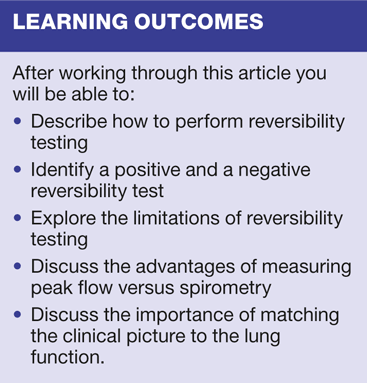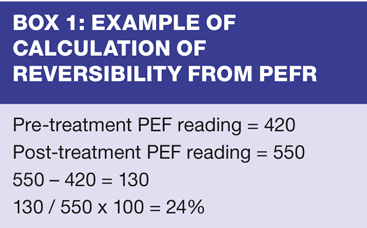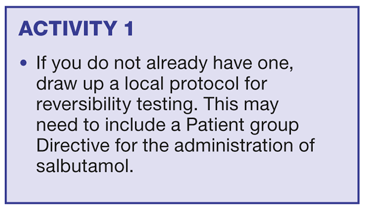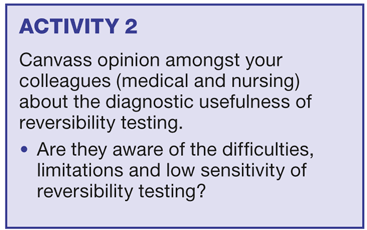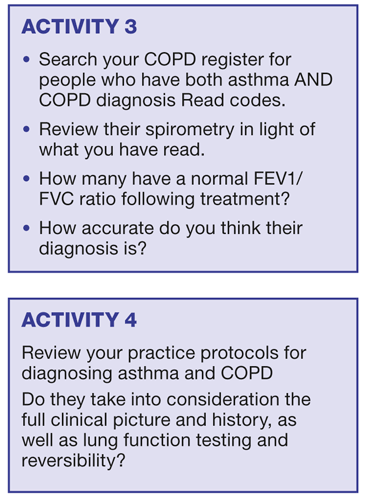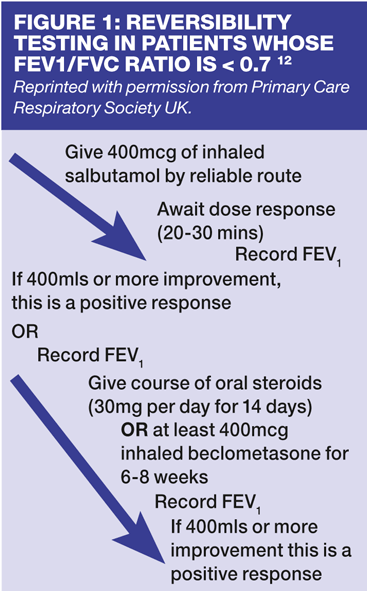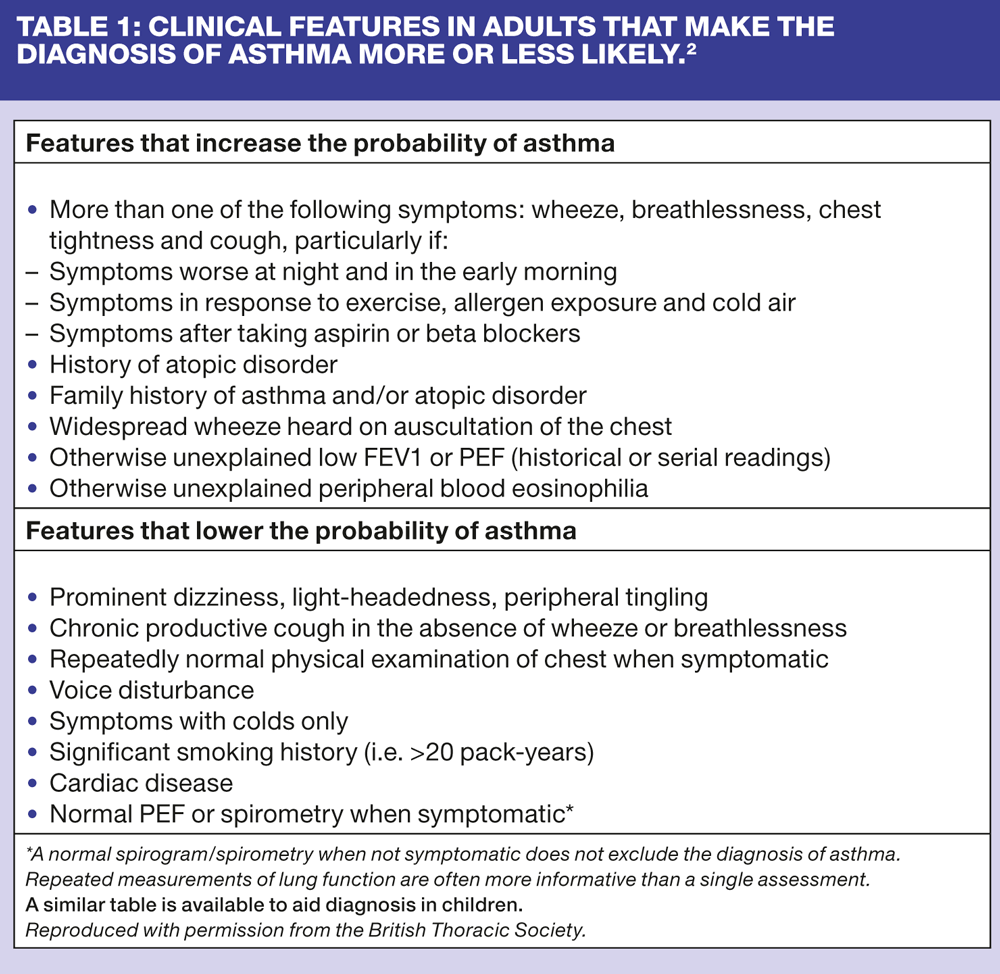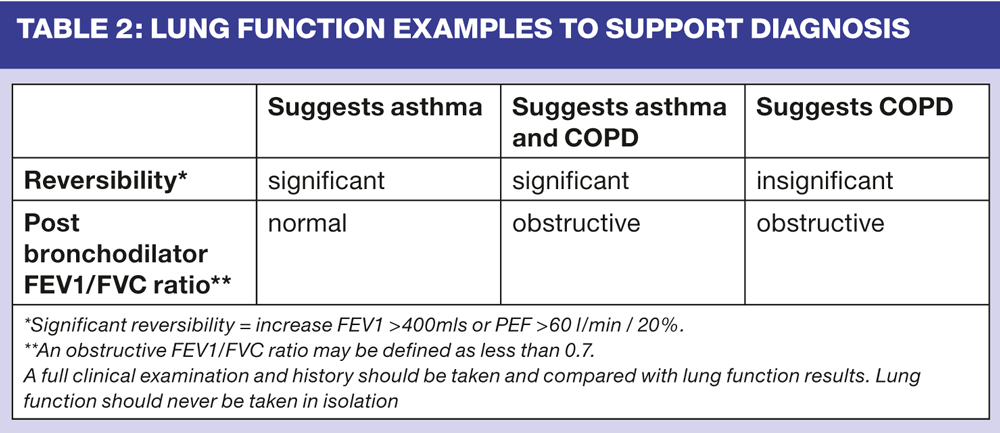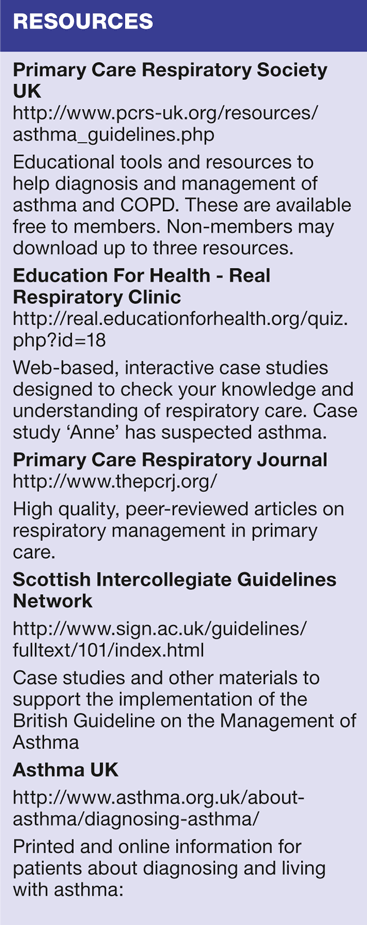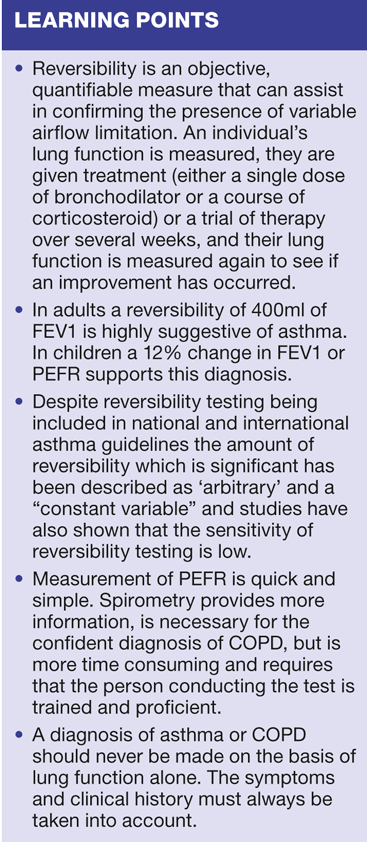Reversibility testing for airflow obstruction
Andrew Booth
Andrew Booth
PG Cert, Dip asthma, Dip COPD, Dip CHD, RGN
Respiratory Specialist Nurse, Sheffield, Primary Care Respiratory Society Executive Committee
Reversibility testing is relatively straightforward and cost effective. It can be useful for confirming, or ruling out asthma, but should not be used in isolation. We look at the evidence for and against this diagnostic tool
Asthma is common, but its diagnosis can be difficult, time consuming and relies heavily on clinical skills and examination. Lung function tests are very useful in identifying airflow obstruction and the identification of reversibility of airflow obstruction has become a recognised way of diagnosing asthma and ruling out chronic obstructive pulmonary disease (COPD). Reversibility testing is relatively simple and cost effective, and can be undertaken in a primary care setting.1 What constitutes reversibility of airflow obstruction is defined within national2,3 and international guidelines,4 and testing for reversibility is encompassed within the Quality Outcomes Framework (QOF) for asthma.5
Despite its inclusion in guidelines and QOF, the evidence base behind reversibility testing is not robust enough to make it a totally accurate way of diagnosing asthma and it should not be used in isolation. Definitions of reversibility have differed from guideline to guideline and have not always been clear. Furthermore, the variable nature of asthma means that reversibility testing is not able to detect all asthma all of the time. Lung function results do not always match the frequency and severity of symptoms experienced by people with asthma, and other obstructive respiratory conditions. The disparity between the evidence and practical considerations on one side and QOF requirements on the other produces a dilemma for primary care professionals. This article discusses the evidence base for reversibility testing, and its limitations. It also discusses possible ways forward, to enable accurate diagnosing of asthma.
VARIABLE AIRFLOW LIMITATION
Asthma and COPD are regarded as separate diseases, yet they have physiological and pathological similarities.6 This can lead to difficulties in diagnosis and the choice of treatment strategies.7 While there are similarities in the treatment of people with asthma and COPD, there are some fundamental differences, particularly in the use of inhaled steroids. This makes accurate diagnosis essential if safe and effective treatment is to be prescribed.
Both asthma and COPD are characterised by airflow limitation, a narrowing of the airways that causes a limitation of the flow of air in and out of the lungs.8 The word 'obstruction' could imply a complete blockage of the airway, whereas 'limitation' implies a reduced flow of air rather than a complete stoppage and is a more accurate description of the physiological problem.
A natural variation in lung function exists in people both with and without obstructive lung disorders. In COPD airflow limitation may vary slightly, but significantly less than in asthma. Most people with asthma have a much greater degree of variation, and it is this aspect of the condition that can be used to detect its presence.9 A little girl with asthma was asked to draw a picture of what her asthma looked like. She drew a picture of a roller coaster, showing that she had, ups and downs, good days and bad days.10 This typical picture of asthma symptoms can be applied to the lung function of somebody with uncontrolled asthma, although it should be noted that symptoms and lung function do not always correlate.11 The important considerations for diagnosing asthma are:
- How much of a variation there is
- How frequently this variation occurs
- How it is measured.
TESTING FOR REVERSIBILITY
Reversibility is an objective, quantifiable measure that can assist in confirming the presence of variable airflow limitation. Quite simply, a person's lung function is measured, they are given treatment, either a single dose of bronchodilator or a course of corticosteroid, and their lung function is measured again to see if an improvement has occurred.12 Three simple steps to reversibility testing are:
1. Pre-treatment measurement of lung function
2. Treatment
3. Post-treatment measurement.
Baseline measurements are usually either Peak Expiratory Flow Rate (PEFR) or Forced Expired Volume in the first second (FEV1). The merits of both measures are discussed briefly below, but whichever measure is used at baseline, the same should be used for the second measure.
Bronchodilator reversibility
Ideally, short-acting bronchodilators should be stopped four hours before testing, subject to the patient's symptoms and need for bronchodilator therapy on the day. If possible the long-acting bronchodilators salmeterol and formoterol should be stopped twelve hours before testing, and the long-acting bronchodilators tiotropium and indacaterol, 24 hours prior to testing. Baseline lung function measurement - PEFR or FEV1 - is taken.
A dose of bronchodilator, usually salbutamol 400mcg delivered one puff at a time via a metered dose inhaler and large volume spacer, is then administered. (400mcg of salbutamol has been suggested in order to standardise reversibility testing.)12
The second measurement is taken after approximately 20 minutes. The degree of reversibility is calculated by subtracting the pre-treatment reading from the post-treatment reading, and then expressing this is a percentage of the highest reading. Box 1 gives an example of this for PEFR.
Some general practice clinical recording systems are able to calculate various lung function values and most modern, electronic spirometers have a function that calculates the difference between pre and post bronchodilator readings. The print out from electronic spirometers also gives the FEV1 as a percentage of the predicted, reference value for that individual and will show the change in that value post bronchodilator. When calculating reversibility it is important to use the change in the actual value of FEV1 obtained and not the change in the percentage of predicted FEV1.
Corticosteroid reversibility
An alternative to reversibility testing with salbutamol is to perform a trial of treatment with inhaled corticosteroids. In adults, most clinicians would try a 6-8 week treatment trial of a daily dose of at least 400mcg inhaled beclometasone (or equivalent). In patients with significant airflow limitation there may be a degree of inhaled corticosteroid resistance and, in this case, a trial with oral prednisolone, 30mg daily for two weeks, may be considered.2
Measurements of lung function, pre and post trial of treatment, must be taken under the same conditions, e.g. if pre-trial of treatment measures are taken after administration of a bronchodilator this should also be given before recording the measurement at the end of the trial. If possible, the lung function measurement taken at the end of the trial should be conducted at the same time of day as at the start.
Figure 1 summarises the approach to reversibility testing.
Trial without treatment
If diagnostic uncertainty remains after bronchodilator and corticosteroid reversibility testing, it may be appropriate to proceed to a trial without treatment. If symptoms or lung function then deteriorate more confidence can be gained about the diagnosis and effectiveness of treatment. Careful planning and discussion with the patient (or parent) is needed if this approach is adopted.
REVERSIBILITY OR VARIATION?
Reversibility is generally referred to as a rapid improvement in lung function following administration of a short-acting bronchodilator, such as salbutamol, or a more sustained improvement following treatment with inhaled steroids.4
Variability refers to an increase and decrease in lung function occurring over time.
Variability may be experienced over one day, when it is known as diurnal variation. It may also be experienced from month to month or seasonally. Measurements of variability may also be useful in the routine management of asthma, as a significant variation is a sign of poor asthma control.4
A defining characteristic of asthma is its variability of both lung function and symptoms, and people with asthma may show obstruction and reversibility one day, but not the next.9,13 A negative reversibility test does not therefore mean that the patient does not have asthma.
FEV1 OR PEFR?
FEV1 and PEFR measure different things and are not interchangeable. PEFR is quick, easy to perform and the equipment is cheap and portable, making it an ideal tool for home monitoring. FEV1 requires spirometry and is an effort-dependent, time-consuming test that needs more expensive equipment, and that needs to be conducted and interpreted by health professionals with appropriate training.1 Spirometry can be performed in primary care, but without appropriate training and quality standards, the risk of poor results increases. Poor technique or inaccurate interpretation of the results could lead to misdiagnosis and suboptimal treatment. When performed and interpreted correctly, however, spirometry provides us with more information. As well as FEV1 it can record vital capacity and FEV1/FVC ratio, which helps in the identification of airflow limitation. For this reason, spirometry is the preferred test to aid the diagnosis of asthma, and essential if COPD is suspected.
Measurement of lung function provides us with information about the severity of airway obstruction, but not the severity of symptoms. It is important to note that lung function and amount of reversibility does not always correlate strongly with symptoms, and some patients may have poor perception of their own airflow limitation.11
HOW RELIABLE IS REVERSIBILITY?
The evidence around what constitutes significant reversibility is difficult to assess, complex, contrary, and has changed frequently.4 In recent years a variety of guidelines have changed their recommendations about how and when reversibility tests should be performed, whether PEFR or FEV1 is preferable, and have used a variety of percentage changes and actual values to determine what is a positive or negative result. The amount of reversibility which is significant has been described as 'arbitrary'3 and a 'constant variable'.14 Studies have also shown that the sensitivity of reversibility testing is low.15
Many people who have asthma will show a degree of reversibility and variation in lung function. However, so do many people with COPD.14 Evidence suggests that people with COPD can experience a change of 160ml in FEV1, and a variability of Forced Vital Capacity (FVC) of 330mls.9,14 This makes it hard to determine if any change is due to a positive reversibility or normal variation, unless the difference is large, e.g. 400mls.16 Furthermore, asthma patients with advanced disease can exhibit responses similar to people with COPD.7 It is for these reasons that the both the British Guideline on the Management of Asthma2 and the current COPD guideline3 suggest that, in adults, a reversibility of 400 ml of FEV1 is highly suggestive of asthma. In children the asthma guideline suggests that a 12% change in FEV1 or PEFR supports a diagnosis of asthma.
The degree of reversibility measured does not always equate to disease severity or response to long-term treatment17 - particularly in those with COPD. In COPD, for example, a positive response to an oral corticosteroid trial does not mean that the patient will have a positive response to inhaled corticosteroids.
For reversibility measured using PEFR, international guidelines suggest that a significant reversibility that supports a diagnosis of asthma is 60l/min or 20%.18
A significant variation in PEFR can be considered to be 20%, or if measured on the same day (diurnal variation) this may be 10%.19 Furthermore a 'morning dip' in peak flow is a classical sign of uncontrolled asthma. Serial PEFR measurements, however, may not always be reliable or accurate due to poor concordance,20 and they have a low sensitivity.21 They may be more useful in the management of established asthma than in making the initial diagnosis. The use of an electronic spirometer or PEFR machine that records the date and time of each reading (rather than the patient having to remember to write it down on a chart) may be more reliable,22 although this equipment is more expensive and not available on prescription.
PRACTICAL CONSIDERATIONS
The evidence behind reversibility testing is not sufficiently robust to make diagnostic conclusions in isolation, and it is not, therefore, the panacea that perhaps is hoped for. So how else can primary care professionals ensure correct diagnosis is achieved?
Both BTS/SIGN2 and NICE3 agree that a diagnosis can only be made following a full assessment and history taking and provide clear guidance about symptoms that are features of COPD and those that may be suggestive of asthma. Before proceeding to lung function testing it may be helpful to ask yourself:
'Do I think this person has asthma, or COPD?'
'I think it might be asthma'
The BTS/SIGN asthma guideline2 provides helpful tables of clinical features that increase or decrease the probability of asthma (Table 1). Following thorough history and examination, the individual (adult or child) can be classified as having either a high, intermediate, or low probability of asthma.
In a patient categorized as having a 'high probability' of asthma, full lung function testing may not be required. It is, however, recommended to add weight to the diagnosis by detecting airway obstruction, defined as an FEV1/FVC ratio of
In those with an 'intermediate probability' of asthma, reversibility testing may be very helpful. Just as importantly, a measurement of the FEV1/FVC ratio is vital to detect airflow obstruction. If the FEV1/FVC ratio returns to normal after reversibility, then clinically significant COPD is not present.3
If the individual has a 'low probability' of asthma, consideration of other diagnoses may be required. Again, spirometry may be useful to detect airflow limitation.
Should a clear diagnosis not be forthcoming, then further physiological and pathological testing, such as induced sputum, exhaled nitric oxide, or methacholine challenge testing may be required, usually as part of a specialist referral.
'I think it might be COPD'
A diagnosis of COPD is made on clinical grounds. It should only be made following a thorough history and examination, in the presence of symptoms such as exertional breathlessness, productive cough and winter bronchitis, and with confirmation of the presence of airflow obstruction on spirometric testing. The latest national guidance states that reversibility testing is not usually necessary, or recommended, for people with COPD,3 except where there is diagnostic uncertainty.
'I think it might be both asthma and COPD'
Between 10%8 and 15%5 of people with COPD may also have asthma. This is becoming known as overlap syndrome.23 The two conditions can exist simultaneously, and may cause the perhaps erroneous belief that the person's 'asthma has turned into COPD.' While both asthma and COPD can be considered inflammatory conditions, there are differences in both the underlying inflammation24 and prognosis, and in the most appropriate management strategies.
Quality assured spirometry with reversibility testing may help to elicit the degree of airflow limitation, and the amount of reversibility. If the FEV1/FVC ratio does not return to normal following a reversibility test (bronchodilator or corticosteroid) or a trial of treatment, then predominantly fixed airways disease, such as COPD, may be considered. If the ratio does not return to normal and the patient demonstrates a positive reversibility of more than 400mls, then a dual diagnosis of asthma and COPD may be suspected (Table 2). Any diagnostic uncertainty should lead to consideration of a referral for specialist advice and further testing, in order to avoid inappropriate treatments being started.
CONCLUSION
Reversibility can be undertaken using PEFR or spirometry. Home PEFR monitoring may also be helpful in detecting the variation in PEFR indicative of asthma, particularly if these changes occur on the same day and the PEFR is lower in the morning. If these PEFR changes can be matched to a record of symptoms and trigger factors this will lend weight and confidence to an asthma diagnosis.
Spirometry can identify airways obstruction, i.e. FEV1/FVC ratio 400mls following salbutamol 100mcg x4 puffs constitutes a positive reversibility, and is highly suggestive of asthma.
Reversibility testing can be helpful for confirming the presence of asthma, but should always be used in conjunction with a full assessment of symptoms, personal and family history, and clinical examination.
A self-assessment exercise is available at the end of this article, below the references.
REFERENCES
1. Levy ML, Quanjer PH, Booker R, Cooper BG, Holmes S, Small I, et al. Diagnostic spirometry in primary care. Prim Care Respir J. 2009 Sep;18(3):130-147
2. British Thoracic Society and Scottish Intercollegiate Guidelines Network (2008) British Guidelines on the Management of Asthma. Updated 2012. http://www.brit-thoracic.org.uk/guidelines/asthma-guidelines.aspx
3. National Institute for Clinical Excellence (NICE). 2010 Management of chronic obstructive pulmonary disease in adults in primary and secondary care (partial update). This guideline partially updates and replaces NICE clinical guideline 12. June 2010. http://publications.nice.org.uk/chronic-obstructive-pulmonary-disease-cg101
4. Global Strategy for Asthma Management and Prevention, Global Initiative for Asthma (GINA) 2011. http://www.ginasthma.org/
5. Quality and Outcomes Framework guidance for GMS contract 2011/12. Available at: http://www.nhsemployers.org/Aboutus/Publications/Documents/QOF_guidance_GMS_contract_2011_12.pdf
6. Fabbri LM, Romagnoli M, Corbetta L, Casoni G, Busljetic K, Turato G, et al. Differences in Airway Inflammation in Patients with Fixed Airflow Obstruction Due to Asthma or Chronic Obstructive Pulmonary Disease. American Journal of Respiratory and Critical Care Medicine. 2003 Feb;167(3):418-424.
7. Sciurba FC Physiologic similarities and differences between COPD and asthma Chest 2004; 126:117s-124s
8. Barnes PJ. Mechanisms in COPD Chest. 2000 Feb;117(2 suppl):10S-14S
9. Tweeddale PM, Alexander F, McHardy GJR. et al Short-term variability in FEV1 and bronchodilator responsiveness in patients with obstructive ventilatory defects. Thorax. 1987; 42(7):487-490.
10. Source: Asthma UK
11. Killian KJ, Watson R, Otis J, Timothy A, O'Byrne. Symptom Perception during Acute Bronchoconstriction. American Journal of Respiratory and Critical Care Medicine. 2000 Aug;162(2):490-496
12. Miller MR, Hankinson J, Brusasco V, Burgos F, Casaburi R, Coates A, et al. Standardisation of spirometry. European Respiratory Journal. 2005 Aug;26(2):319-338
13. Small I, Levy M Opinion Sheet No 30 Diagnosis of Asthma In Adults. Primary Care Respiratory Society UK. 2009 http://www.pcrs-uk.org
14. Calverley PMA, Burge PS, Spencer S et al Bronchodilator reversibility testing in chronic obstructive pulmonary disease Thorax 2003;58:659-664
15. Smith AD, Cowan JO, Filsell S, et al. Diagnosing asthma: comparisons between exhaled nitric oxide measurements and conventional tests. Am J Respir Crit Care Med. 2004;169(4):473-8
16. Nisar M, Earis JE, Pearson MG, et al. Acute bronchodilator trials in chronic obstructive pulmonary disease. Am Rev Respir Dis 1992;146:555-9.
17. Burge PS, Calverley PMA, Jones PW et al. Prednisolone response in patients with chronic obstructive pulmonary disease: results from the ISOLDE study. Thorax. 2003; 58:1-5
18. Dekker FW, Schrier AC, Sterk PJ, Dijkman JH Validity of peak expiratory flow measurement in assessing reversibility of airflow obstruction Thorax 1992 47: 162-166
19. Boezen HM, Schouten JP, Postma DS, Rijcken B. Distribution of peak expiratory flow variability by age, gender and smoking habits in a random population sample aged 20-70 yrs. Eur Resp J 1994 Oct;7(10):1814-1820
20. Brouwer AFJ, Roorda RJ, Brand PLP. Home spirometry and asthma severity in children. Eur Resp J 2006 Dec;28(6):1131-1137
21. Higgins BG, Britton JR, Chinn S, Jones TD, Jenkinson D, Burney PG, et al. The distribution of peak expiratory flow variability in a population sample. American Rev Respir Dis 1989 Nov;140(5):1368-1372
22. Chowienczyk PJ, Parkin DH, Lawson CP, Cochrane GM Do asthmatic patients correctly record home spirometry measurements? BMJ 1994;309:1618
23. Gibson PG, Simpson JL. The overlap syndrome of asthma and COPD: what are its features and how important is it? Thorax. 2009 Aug;64(8):728-735
24. Barnes A, Rodger IW, Thomson NC Asthma Basic Mechanisms and Clinical Management (third edition). Academic Press Limited; 1998
SELF ASSESSMENT
Answer the questions then scroll down to check your answers.
Question 1
A 30 year old male attends the surgery complaining of shortness of breath on exertion. He is judged to have an intermediate probability of asthma and undergoes a bronchodilator reversibility test in the surgery. How much of an increase in FEV1 could constitute clinically significant reversibility?
1. 150mls
2. 200mls
3. 400mls
4. 200mls and 15%
5. 150mls and 20%
Question 2
A 9 year old girl with a history suggestive of asthma undergoes a bronchodilator reversibility test, using a peak flow meter, in the surgery. How much of an increase in PEFR could constitute a clinically significant reversibility?
1. 20 l/min or 10%
2. 20 l/min and 10%
3. 60 l/min or 20%
4. 60 l/min or 15%
5. 80 l/min or 25%
Question 3
A 45 year old woman with an unproductive cough at night, chest tightness and breathlessness in dusty rooms or when visiting their neighbour who has cats, is sent to you for reversibility testing. She is an ex-smoker with a 15 pack year smoking history, having stopped smoking in her mid 20s. You perform spirometry with reversibility, using 400mcg of salbutamol through a spacer. Although the FEV1/FVC ratio shows an obstructive pattern and the FEV1 is mildly reduced, you are unable to demonstrate reversibility. What might be your next course of action?
1. Diagnose COPD
2. Ask her to come back another day and do the bronchodilator reversibility test again
3. Confirm asthma due to appropriate symptoms in presence of known triggers.
4. Tell her that she does not have asthma.
5. Suggest that she has a trial of treatment with 200mcg inhaled beclometasone (or equivalent) twice daily, with home peak flow monitoring.
Question 4
The senior partner in your practice has asked you to re-test all patients on the asthma register who do not have a positive reversibility test recorded, as this is a requirement for QOF.
What might be the best course of action?
1. Re-test all patients, then remove those who do not have a positive reversibility from the asthma register, and place them on the COPD register.
2. Explain that those people with asthma who are currently well controlled may not have any reversibility at all, but still need to be on the asthma register.
3. Only re-test those who have an obstructive FEV1/FVC ratio.
4. Suggest that, instead of doing bronchodilator reversibility testing, it would be better to do oral corticosteroid reversibility tests.
5. Re-test all those with obstructive FEV1/FVC ratios, using ipratropium bromide instead of salbutamol, as patients with COPD are more likely to respond.
Question 5
You perform spirometry with bronchodilator reversibility on a 35 year old man late one afternoon. He has a long-standing history of asthma and is currently taking 200mcg budesonide a day via Turbohaler (his inhaler technique is good) and terbutaline as needed. He says that his chest has felt 'tight' in the morning recently and he has experienced some asthma symptoms on exertion. His pre-bronchodilator FEV1/FVC ratio is 0.77, showing that he does not have an obstructive pattern, according to guideline definition. What can you conclude from this?
1. Because his spirometry is not obstructive he does not have asthma.
2. Because his spirometry is not obstructive his asthma is well controlled.
3. The history suggests that his asthma is not optimally controlled. Serial PEFR may demonstrate a 'morning dip', or spirometry performed in the morning may reveal obstruction.
4. He has not performed the spirometry test properly.
5. He must have just used his terbutaline inhaler.
Question 6
A 10 year old boy with a history suggestive of asthma has had an inconclusive bronchodilator reversibility test and has gone home to do a two week serial PEFR recording. How much of a variation in serial PEFR readings would lead you to suspect a diagnosis of asthma?
1. 20 l/min
2. 20%
3. 200 l/min
4. 10%
5. 100 l/min
Question 7
What is the guideline defined standard dose of salbutamol for reversibility testing?
1. 200mcg - 2 puffs into a spacer
2. 400mcg - 4 puffs into a spacer, one puff at a time
3. 600mcg - 6 puffs into a spacer
4. 2.5mg via nebuliser
5. 5mg via nebuliser
Question 8
What is the correct formula for working out the amount of reversibility?
1. (post reading -pre reading) / post reading x 100.
2. (pre reading -post reading) / post reading x 100.
3. (pre reading -post reading) / pre reading x 100.
4. (post reading/100) X pre reading
5. (pre reading/100) X post reading
Question 9
When performing reversibility testing, approximately how long after the dose of salbutamol is administered, should you perform the post-bronchodilator test?
1. 5 minutes
2. 10 minutes
3. 15 minutes
4. 20 minutes
5. 30 minutes
Question 10
How should an oral corticosteroid trial be conducted?
1. Pre-bronchodilator baseline lung function test, followed 30mg prednisolone in the morning for 1 week, followed by post-bronchodilator lung function testing.
2. Post-bronchodilator baseline lung function test, followed by 10mg prednisolone in the morning for 2 weeks, followed by pre-bronchodilator lung function test.
3. Pre-bronchodilator lung function test, followed by 30mg prednisolone in the morning for 2 weeks, reducing to 10mg in the morning for a further 2 weeks, followed by post-bronchodilator lung function testing.
4. Baseline lung function test, followed by 30mg prednisolone in the morning for 2 weeks, followed by lung function testing under the same conditions as the baseline test.
5. 30mg prednisolone in the morning for 2 weeks, with serial PEFR monitoring.
ANSWERS
Q1: 3. 400mls
People who have asthma will show a degree of reversibility and variation in lung function. However, so do many people with COPD. Individuals with COPD may demonstrate 160ml variability in the FEV1 and up to 330ml in the FVC, making it hard to determine if any change is due to positive reversibility or normal variation, unless the change is large - i.e. 400ml. Both the British Guideline on the Management of Asthma and the current COPD guideline suggest that, in adults, a reversibility of 400ml of FEV1 is highly suggestive of asthma.
Q2: 3. 60l/min or 10%
Q3: 5. Suggest she has a trial of treatment with 200mcg beclometasone (or equivalent) twice daily, with home peak flow monitoring.
This woman's symptoms are highly suggestive of asthma. Although COPD cannot be excluded, it is unlikely. A trial of inhaled corticosteroids with home peak flow monitoring is a reasonable next step to confirm a diagnosis of asthma in this case.
Q4: 2. Explain that those people with asthma who are currently well controlled may not have any reversibility at all, but still need to be on the asthma register.
Asthma is a variable condition, which may include periods of stability, and not all people with asthma will demonstrate reversibility all of the time.
Q5: 3. The history suggests that his asthma is not optimally controlled.
Q6: 2. 20%
A 20% variation in PEFR can be considered significant, or 10% if this is measured on the same day (diurnal variation). A 'morning dip' is a classical sign of uncontrolled asthma. However, serial PEFR measurements may not always be reliable or accurate, and may be more useful in the management of established asthma than in making the initial diagnosis.
Q7: 2. 400mcg - 4 puffs into a spacer, one puff at a time.
Q8: 1. (post reading -pre reading) / post reading x 100
Q9: 4. 20 minutes
Q10: 4. Baseline lung function test, followed by 30mg prednisolone in the morning for 2 weeks, followed by lung function testing under the same conditions as the baseline test.
Related articles
View all Articles

